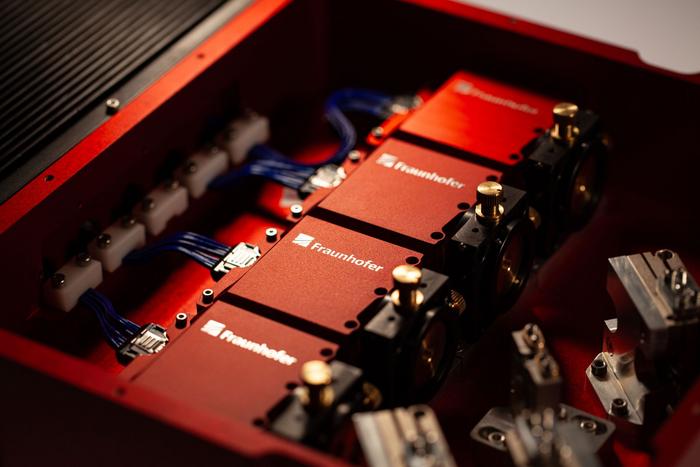
Resonantly tunable quantum cascade lasers (QCLs) have emerged as transformative light sources in the field of mid-infrared (MIR) spectroscopy, renowned for their exceptional brilliance and wavelength tunability. These semiconductor lasers operate on intersubband transitions within quantum well heterostructures, enabling access to spectral regions between 4 and 11 micrometers—a range rich with molecular vibrational fingerprints essential for chemical analysis. The unique capability of QCLs to deliver high power and narrow linewidth emission over broad spectral bands allows rapid and precise spectroscopic measurements, critical for applications across chemical processing, pharmaceuticals, environmental monitoring, and security. Despite these compelling advantages, widespread industrial adoption has been hampered by the complexities and costs associated with manufacturing robust, tunable QCL modules.
Addressing these challenges, the Fraunhofer Institute for Applied Solid State Physics IAF has pioneered a semi-automated assembly process for QCL modules integrated with micro-opto-electro-mechanical systems (MOEMS) based external optical cavities. This innovative method marries a MOEMS grating scanner with the external cavity quantum cascade laser design, yielding what is known as MOEMS-EC-QCL technology. By leveraging precision microfabrication and a pick-and-place system in the production line, the new approach drastically reduces assembly time and production expense, which were formerly prohibitive due to manual active alignment requirements. This breakthrough sets the stage for scalable manufacture of cost-effective, high-performance tunable QCL modules suitable for broad industrial use.
One of the most compelling advantages of the MOEMS-EC-QCL platform lies in its ability to combine multiple laser modules with complementary spectral coverage into a single multi-core system. Each individual QCL module inherently covers a constrained spectral window, but by orchestrating several modules spanning different ranges, users can achieve continuous spectral coverage over the entire 4 to 11 micrometer band. This modular architecture not only enhances spectral measurement bandwidth but also escalates achievable wavenumber scanning speeds to over one million wavenumbers per second. Such real-time, broad-range spectral acquisition capabilities are unprecedented in traditional MIR laser systems, opening new horizons for advanced inline sensing and quality control applications.
.adsslot_ZJfHP9WgLt{width:728px !important;height:90px !important;}
@media(max-width:1199px){ .adsslot_ZJfHP9WgLt{width:468px !important;height:60px !important;}
}
@media(max-width:767px){ .adsslot_ZJfHP9WgLt{width:320px !important;height:50px !important;}
}
ADVERTISEMENT
Dr. Marko Haertelt, head of the Laser Measurement Technology Group at Fraunhofer IAF, emphasizes that the fusion of high brilliance and spectral agility through MOEMS diffraction gratings significantly propels the state of the art in Fourier-transform infrared (FTIR) spectroscopy-based measurement techniques. The scalable multi-core approach addresses critical industry demands by reducing the diversity and inventory of discrete modules needed, thereby fostering economies of scale while enhancing system versatility. This evolution permits the deployment of compact, integrated QCL systems tailored for specific application spectra, aligning with stringent industrial requirements for speed, precision, and cost-efficiency.
Historically, the assembly of MOEMS-EC-QCL modules posed substantial obstacles. Active alignment stages demanded painstaking manual optical adjustments, consuming considerable time and skilled labor—factors that compounded the cost barrier. Fraunhofer IAF’s semi-automated process revolutionizes this workflow by integrating micropositioning and pick-and-place robotics to deterministically assemble and align critical optical and mechanical components. This not only accelerates production rates but also ensures repeatability and quality consistency, enabling wider distribution of tunable MIR laser sources beyond specialized research environments.
The potential applications for these advanced MOEMS-EC-QCL laser systems span a broad spectrum of scientific and industrial sectors. In semiconductor manufacturing, the capability to perform rapid, nondestructive inline metrology on epitaxial layer thicknesses and doping profiles promises substantial yield improvements. In chemical process analytics, the high-speed detection and monitoring of reaction intermediates facilitate optimized reaction conditions, thereby enhancing product quality and reducing waste. Security technologies benefit from the increased sensitivity and selectivity provided by MIR absorption spectroscopy for detecting hazardous substances and volatile organic compounds, offering crucial enhancements for public safety and law enforcement.
Key to the impact of this laser technology is its ability to acquire complete infrared spectra within milliseconds, a speed that outperforms conventional thermal sources and many laser-based alternatives. This rapid spectral acquisition is made possible by the finely tunable output enabled by the MOEMS scanner in the external cavity configuration, which sweeps across spectral features with high mechanical precision and minimal optical losses. The resulting spectral data fidelity and acquisition velocity empower new methodologies in point-of-interest spectroscopy, ATR (attenuated total reflectance), and microfluidic sampling techniques, thereby advancing capabilities in biomedical diagnostics and environmental sensing.
Fraunhofer IAF’s upcoming demonstration at the Laser World of Photonics 2025 will feature a multi-core laser system consisting of four semi-automatically manufactured MOEMS-EC-QCL modules integrated alongside custom peripherals. This exhibit, hosted at the Fraunhofer booth in Munich, will underscore the practical readiness of the technology and its applicability across various measurement methods. The multi-core setup exemplifies modularity and scalability, embodying a versatile platform for next-generation MIR spectroscopy systems adapted to diverse industrial workflows.
The technological advancements are underpinned by the BMFTR-funded AIRLAMet project, which aims to develop cutting-edge electro-optical measurement systems capable of inline production control in semiconductor manufacturing. Collaborators Fraunhofer IAF, Fraunhofer IPMS, and Sacher Lasertechnik GmbH, coordinated by sentronics metrology GmbH, have leveraged the developed MOEMS-EC-QCL modules as the cornerstone laser light sources for this novel metrology solution. The project milestone demonstrates not only technological prowess but also a clear path towards integration into existing manufacturing ecosystems.
Fraunhofer IAF’s expertise in III-V semiconductor materials and synthetic diamond platforms fuels continuous innovation across optoelectronic device engineering. Their approach spans material synthesis, nanofabrication, device design, and system-level integration, enabling the creation of compact, robust components such as the MOEMS-EC-QCL modules. By bridging fundamental physics with process engineering, the institute translates laboratory breakthroughs into commercially viable laser technologies that address pressing industrial and societal needs.
The combination of MOEMS technology with quantum cascade laser design represents a significant leap forward in photonic engineering. This hybridization synergizes mechanical tuning elements with quantum-engineered gain media to deliver unparalleled flexibility in mid-infrared laser sources. The resulting devices offer tunability, rapid spectral scanning, and high optical power in compact formats—an elusive trifecta not achievable through conventional laser configurations. As such, these devices pave the way for widespread deployment of MIR spectroscopy beyond the confines of specialized labs to point-of-use and even handheld platforms.
Looking ahead, the scalable and cost-efficient manufacturing framework developed by Fraunhofer IAF and partners promises to catalyze adoption across small and medium-sized enterprises (SMEs) that previously faced insurmountable barriers due to cost and technical complexity. By democratizing access to tunable MIR laser systems, these technologies will enable smarter, faster, and more precise analytical instrumentation, fostering innovation and productivity across multiple sectors including pharmaceuticals, environmental monitoring, and semiconductor fabrication.
Subject of Research: Development and semi-automated production of MOEMS-based external cavity quantum cascade laser modules enabling multi-core spectroscopic systems for mid-infrared spectroscopy.
Article Title: Fraunhofer IAF Advances Semi-Automated Production of Multi-Core MOEMS-EC-QCLs for Revolutionary Mid-Infrared Spectroscopy
News Publication Date: June 2025
Image Credits: © Fraunhofer IAF
Keywords
Laser systems; Ultrafast laser spectroscopy; Applied optics; Technology; Lasers; Laser physics; Spectroscopy
Tags: advancements in laser manufacturingchemical analysis with QCLscost-efficiency in laser manufacturingenvironmental monitoring using lasersexternal cavity quantum cascade lasersindustrial adoption of quantum cascade lasersmid-infrared spectroscopy applicationsMOEMS technology in lasersprecision microfabrication techniquesquantum cascade laser productionsemi-automated assembly processestunable semiconductor lasers


